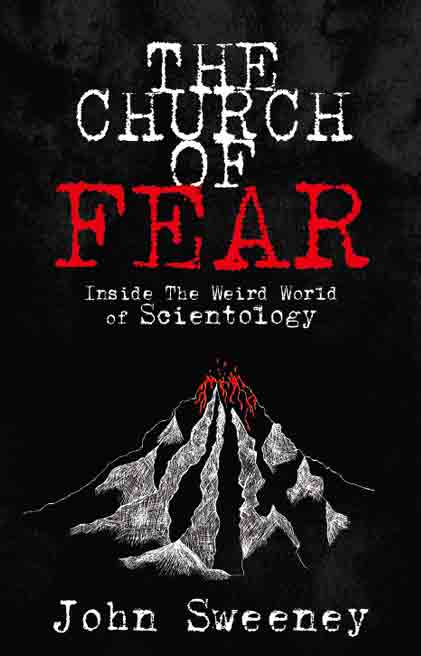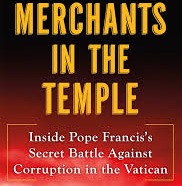
The Church of Fear by John Sweeney (Silvertail)
Sweeney probably figured that he might as well write this book. His name has been inextricably linked – or, at least, inextricably search-engine-optimised – with Scientology since 2007, when he made a documentary about the organisation for BBC’s Panorama. As appears to be Scientology’s standard operating procedure when anyone asks questions, Sweeney was followed, pestered and goaded until he lost his temper, memorably and deafeningly, at Tommy Davis, then a leading Scientology panjandrum. Sweeney did a fair impression of, in his own words, “an exploding tomato”: the video of his eruption, gleefully uploaded by the Scientology surveillance team, went viral.
Sweeney says sorry for his outburst, not for the first time, in the introduction of The Church of Fear. It’s about the last thing for which he does apologise, and quite rightly (and indeed Sweeney doesn’t seem altogether abashed about the exploding tomato moment: a still from the footage of the incident serves as his Twitter avatar). The Church of Fear essentially tells two stories. One is the story of the Church of Scientology. The other is the story of what happens when a journalist tries to find out anything about the Church of Scientology. Both yarns are extremely odd, somewhat alarming and occasionally blackly comic.
It’s a combination that suits Sweeney, who has a fascination with the grotesqueries of power (previous books have included studies of Nicolae Ceausescu, Aleksandr Lukashenko and Neil and Christine Hamilton). His portrait of the Church of Scientology, and its current leader, David Miscavige, is unflattering. Sweeney’s interviews with former members depict Scientology as a ruthless and efficient racket for relieving the vulnerable and foolish of their money (and often, along the way, their dignity, sanity and family), run by a pompous, paranoid bully.
The church, as Sweeney reminds with a metronomic regularity that escalates into a glorious running joke, deny all of this. But there is no poorer advertisement for Scientology in Church of Fear than the behaviour of Sweeney’s quarry, irrefutably documented by Sweeney’s film crew: Sweeney is harassed, menaced and obstructed at every turn.
There is a rugged logic to this approach from Scientology’s perspective.
Most journalists and most news agencies are already pathetically squeamish about confronting faith – Mitt Romney, adherent of another modern American religion, sauntered through an entire presidential campaign without once being asked a serious, detailed question about the foundations of his personal philosophy. If a church encourages this reluctance further with the certainty of inconvenience and the threat of expensive legal action, most will back off, and most do – especially in Britain, whose libel laws might have been written by a professional querulous litigant.
Though Sweeney’s book is being published here – by a small independent imprint with no distribution, after every major house rejected it – the Scientology expose Going Clear, by Pulitzer-winning New Yorker journalist Lawrence Wright, was pulled from UK schedules by Transworld last year.
Sweeney spends little of The Church of Fear analysing the tenets of Scientology, and rightly, these being less interesting than what the church does to its members, and with its members’ money. And at any rate, Scientology’s foundation beliefs are no sillier than those of any other religion, and indeed it’s almost tempting to admire Hubbard’s fuck-it-why-not approach to assembling a mythology: as long as we’re making stuff up, you might as well command people to worship a volcano-dwelling alien deity who dispatched legions of tormented pupae across the galaxy in a fleet of inexplicably propeller-powered DC-8s, in the hope that they might metamorphosise into radiant celestial beings after having their palms read by a trouser press (or whatever it is: this reviewer confesses to haziness re the details, but offers in mitigation of this dereliction the defence that it doesn’t matter).
One is also compelled, despite the evidence of malfeasance marshalled in Church of Fear, to grudgingly applaud Hubbard’s genius for marketing. When establishing a new faith, no qualities can be more desirable in apostles than vanity, credulity, popularity, charisma and money; it’s incredible, really, that there has ever been a prophet who didn’t go to pains to enlist actors. Though the glorious prospect of a meeting between Sweeney and Tom Cruise and/or John Travolta never materialises, Sweeney does meet a few of Scientology’s acolytes from the capering and pretending trade, including Leah Remini and Kirstie Alley; in an aside that should provoke cries for Harry, England and St George all round, Sweeney notes that Scientology’s highest-profile British recruit to date is Peaches Geldof.

